Eurasian bullfinch
The Eurasian bullfinch, common bullfinch or bullfinch (Pyrrhula pyrrhula) is a small passerine bird in the finch family, Fringillidae. In Anglophone Europe it is known simply as the bullfinch, as it is the original bird to bear the name bullfinch.
| Eurasian bullfinch | |
|---|---|
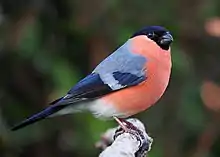 | |
| Male in Lancashire, UK | |
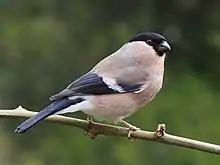 | |
| Female in Lancashire, UK | |
| Scientific classification | |
| Kingdom: | Animalia |
| Phylum: | Chordata |
| Class: | Aves |
| Order: | Passeriformes |
| Family: | Fringillidae |
| Subfamily: | Carduelinae |
| Genus: | Pyrrhula |
| Species: | P. pyrrhula |
| Binomial name | |
| Pyrrhula pyrrhula | |
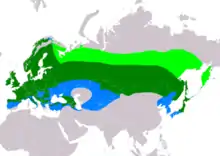 | |
| Range of P. pyrrhula Breeding Resident Non-breeding | |
| Synonyms | |
|
Loxia pyrrhula Linnaeus, 1758 | |
Taxonomy and systematics
The Eurasian bullfinch was listed in 1758 by Linnaeus in the 10th edition of his Systema Naturae under the binomial name Loxia pyrrhula.[2][3] The Latin word pyrrhula comes from the Greek πυρρός (a flame-coloured bird, from πυρρός flame coloured, from πυρ fire : Pyrrha), a 'worm eating bird' that is mentioned by Aristotle.[4] The Latin name for the species had been used by Swiss naturalist Conrad Gesner in his Historiae animalium of 1555.[5]
The closest relatives of the bullfinches are in the genus Pinicola (the pine grosbeak).[6][7]
Subspecies
The described subspecies include:[8]
- British bullfinch (P. p. pileata) W. MacGillivray, 1837 – the British Isles
- Western European bullfinch (P. p. europaea) Vieillot, 1816 – western and central Europe
- Iberian bullfinch (P. p. iberiae) Voous, 1951 – mountains of southwestern France, northern Portugal and northern Spain
- Northern European bullfinch (P. p. pyrrhula) (Linnaeus, 1758) – northern, south-central and eastern Europe across Siberia and central Asia to the Sea of Okhotsk
- Caucasian bullfinch (P. p. rossikowi) Derjugin & Bianchi, 1900 – Turkey, the Caucasus and northwestern Iran
- Caspian bullfinch (P. p. caspica) Witherby, 1908 – Azerbaijan and northern Iran
- Baikal bullfinch (P. p. cineracea) Cabanis, 1872 – Siberia, northeastern Kazakhstan, Mongolia and China
- Cassin's bullfinch (P. p. cassinii) S.F. Baird, 1869 – the Russian Far East and northeastern China
- grey-bellied bullfinch (P. p. griseiventris) Lafresnaye, 1841 – the Russian Far East, China, Korea and Japan
The Azores bullfinch (P. murina), previously regarded as a subspecies of the Eurasian bullfinch, is now recognised as a separate species.[9][10]
Description
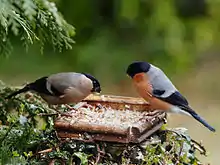
The Eurasian bullfinch is a bulky bull-headed bird. The upper parts are grey; the flight feathers and short thick bill are black; as are the cap and face in adults (they are greyish-brown in juveniles), and the white rump and wing bars are striking in flight. The adult male has red underparts, but females and young birds have grey-buff underparts. It moults between July and October, but males do not have the duller autumn plumage that is typical of some other finches.[11] The song of this unobtrusive bird contains fluted whistles, and is often described as 'mournful'.
Distribution and habitat
This bird breeds across Europe and temperate Asia. It is mainly resident, but many northern birds migrate further south in the winter. Mixed woodland with some conifers is favoured for breeding, including parkland and gardens.
Behaviour and ecology
This species does not form large flocks outside the breeding season, and is usually seen as a pair or family group.
Breeding
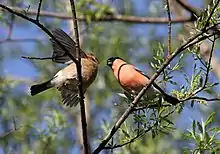
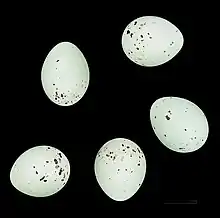
It builds its nest in a bush, (preferably more than four metres tall and wide), mature stands of scrub, or tree, laying four to seven eggs. It is peculiar among the Passeriformes for having spermatozoa with a rounded head and a blunt acrosome.[12]
Feeding

The food is mainly seeds and buds of fruit trees, which can make it a pest in orchards: in England, for centuries every parish paid a bounty for every Eurasian bullfinch killed. Ash and hawthorn are favoured in autumn and early winter.[13] If wild bird cover is planted for it, kale, quinoa and millet are preferred, next to tall hedges or woodland.
References
- BirdLife International (2016). "Pyrrhula pyrrhula". IUCN Red List of Threatened Species. 2016: e.T22720671A88701615. doi:10.2305/IUCN.UK.2016-3.RLTS.T22720671A88701615.en.CS1 maint: uses authors parameter (link)
- Paynter, Raymond A. Jnr., ed. (1968). Check-list of birds of the world, Volume 14. Cambridge, Massachusetts: Museum of Comparative Zoology. p. 296.
- Linnaeus, C. (1758). Systema Naturæ per regna tria naturae, secundum classes, ordines, genera, species, cum characteribus, differentiis, synonymis, locis, Volume 1 (in Latin). v.1 (10th ed.). Holmiae:Laurentii Salvii. pp. 171–172.
- Jobling, James A. (2010). The Helm Dictionary of Scientific Bird Names. London: Christopher Helm. p. 327. ISBN 978-1-4081-2501-4.
- Gesner, Conrad (1555). Historiæ animalium liber III qui est de auium natura. Adiecti sunt ab initio indices alphabetici decem super nominibus auium in totidem linguis diuersis: & ante illos enumeratio auium eo ordiné quo in hoc volumine continentur (in Latin). Zurich: Froschauer. pp. 701–702.
- Arnaiz-Villena, A; et al. (2001). "Phylogeography of crossbills, bullfinches, grosbeaks,and rosefinches" (PDF). Cellular and Molecular Life Sciences. 58 (8): 1159–1166. doi:10.1007/PL00000930. PMID 11529508.
- Arnaiz-Villena, A; Gómez-Prieto P; Ruiz-de-Valle V (2009). "Phylogeography of finches and sparrows". Animal Genetics. Nova Science Publishers. ISBN 978-1-60741-844-3. Archived from the original on 2012-09-02. Retrieved 2012-08-30.
- "Eurasian Bullfinch". Internet Bird Collection (HBW 15, p. 609). Lynx Editions. 2010. Retrieved 1 July 2012.
- Sangster, G.; et al. (2011). "Taxonomic recommendations for British birds: seventh report". Ibis. 153 (4): 883–892. doi:10.1111/j.1474-919X.2011.01155.x.
- Gill, Frank; Donsker, David (eds.). "Finches, euphonias". World Bird List Version 5.3. International Ornithologists' Union. Retrieved 23 August 2015.
- RSPB Handbook of British Birds (2014). ISBN 978-1-4729-0647-2.
- Birkhead, Timothy R.; Immler, Simone; Pellatt, E. Jayne; Freckleton, Robert (2006). "Unusual sperm morphology in the Eurasian Bullfinch (Pyrrhula pyrrhula)". Auk. 123 (2): 383–392. doi:10.1642/0004-8038(2006)123[383:USMITE]2.0.CO;2.
- Dyda J, Symes N and Lamacraft D (2009) Woodland management for birds: a guide to managing woodland for priority birds in Wales. The RSPB, Sandy and Forestry Commission Wales, Aberystwyth, ISBN 978-1-905601-15-8
| Wikimedia Commons has media related to Pyrrhula pyrrhula. |
